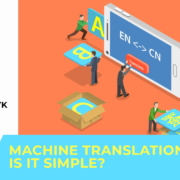Machine Translation: Is It Simple?
Machine translation (MT) has been around for a long time, and now it has advanced to the point where machine translation post-editing (MTPE) has become a standard practice at major language service providers. Nevertheless, many customers, linguists, and even the managers of various LSPs still believe that MT is difficult and inherently of low quality.
We have decided to outline a few points that might give you some pause for thought.
Machine translation should be of good quality
The quality of machine translation can vary greatly: it can be very good or very bad. Most notably, the same text may be both at the same time. “Very good” can apply to both raw MT and cases where minimal post-editing is needed to meet the technical specifications for a text.
The key idea is that machine translation engines must be appropriately chosen or trained, and there should be no reservations about using artificial intelligence for certain tasks.
Of course, there are exceptions for certain language pairs and domains, but in most cases, MT surpasses all expectations with the right setup and when all stages of the process are executed in the right sequence.
Therefore, specialists within a company who possess expertise in this field play an important role in shaping the perception of MT, and the results of their work can radically change people’s attitudes toward it.
Machine translation requires training
In addition to the training needed for generating text of optimal quality for post-editing, it is essential to train linguists in the specific type of post-editing that is required. In translation in general, and even more so in post-editing, there is no universal standard when it comes to criteria. Therefore, when a linguist claims to have post-editing skills, it does not necessarily mean that they know how to perform both light and full MTPE. The development of e-learning courses is certainly necessary for both linguists and employees in certain departments.
Machine translation is present even where it shouldn’t be
Additionally, based on our extensive experience in evaluating machine translations, there is no hiding the fact that many linguists who are reluctant to engage in MTPE and categorically reject MT do, in fact, use it without informing the LSP in order to speed up their work. Given that linguists are unlikely to conduct MT evaluations and select the most suitable engine for each project, they end up spending more time processing text. This, in turn, leads to LSPs also spending more time on these projects or having to employ more linguists to work on them.
The truth is that MT can be both simple and challenging. However, it is important for every professional or company to consider incorporating this emerging field into their area of expertise. This is particularly true because the rapid technological progress we are currently witnessing has already surpassed standard MT, and new promising areas are being explored. Here, we can only advise you to boldly embrace change and keep up with the times!






